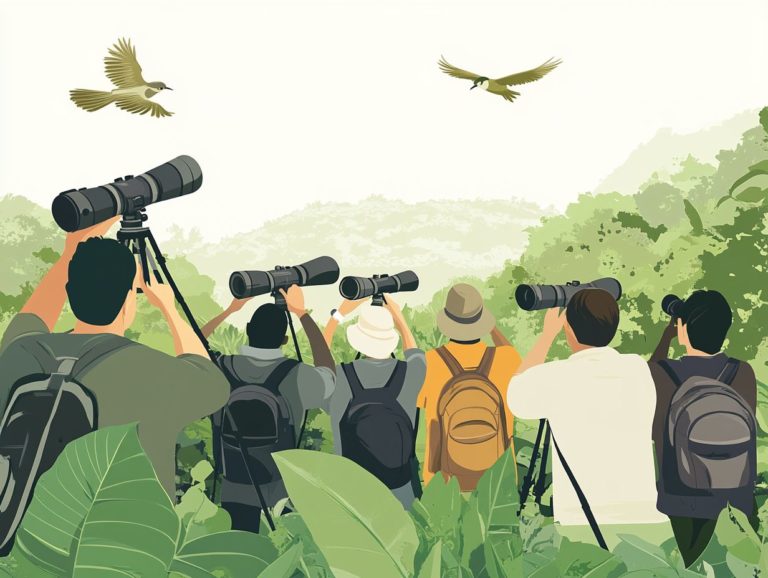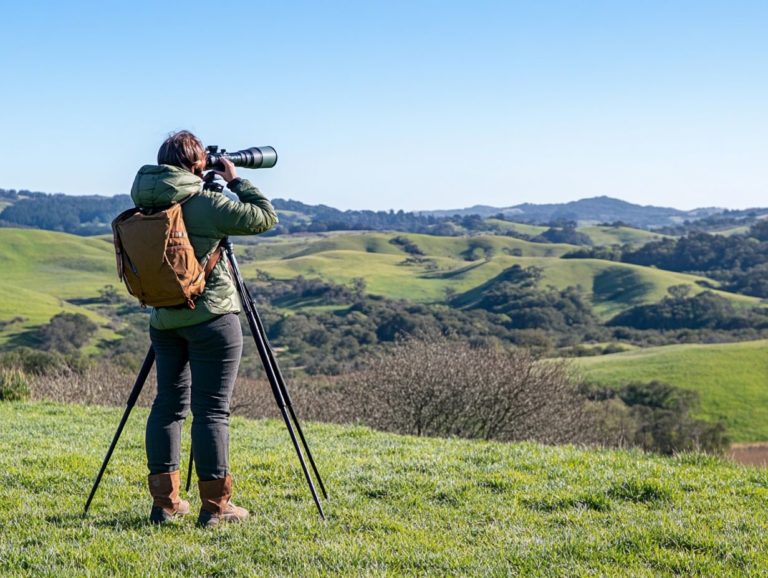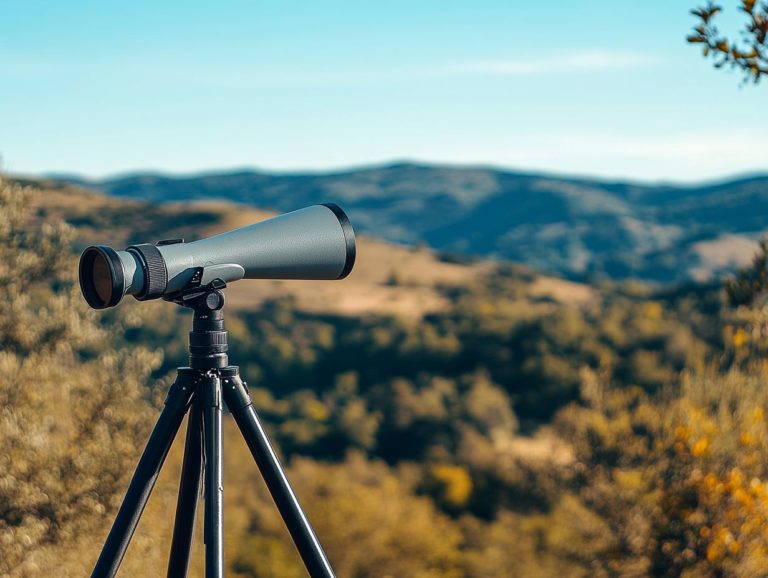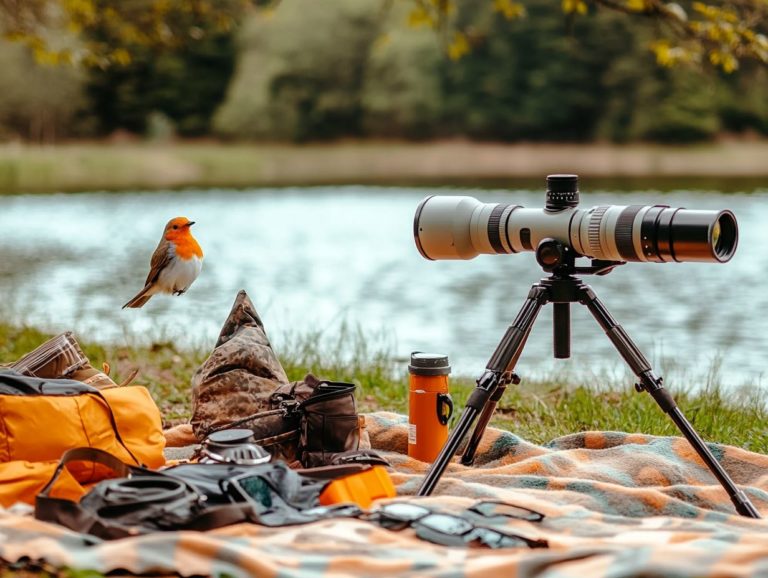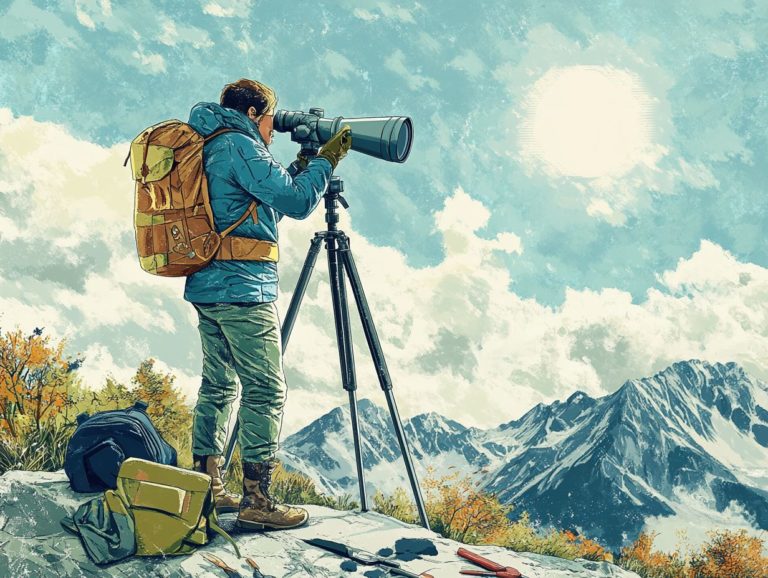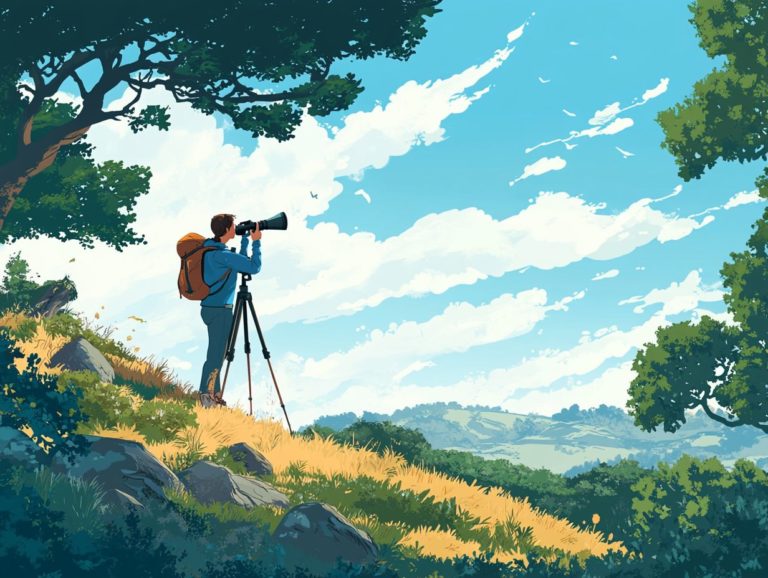How to Use a Spotting Scope with a Camera
If enhancing your wildlife photography or landscape shots is on your agenda, a spotting scope can truly be a game-changer.
These powerful optical devices provide exceptional magnification and clarity, making them ideal for capturing distant subjects that often elude the naked eye. You ll discover what a spotting scope is, how it operates, and the many benefits of pairing it with your camera.
You will also receive essential tips for maintaining your gear, allowing you to focus entirely on capturing stunning images.
Jump in now and unleash the full power of your photography skills!
Contents
Key Takeaways:
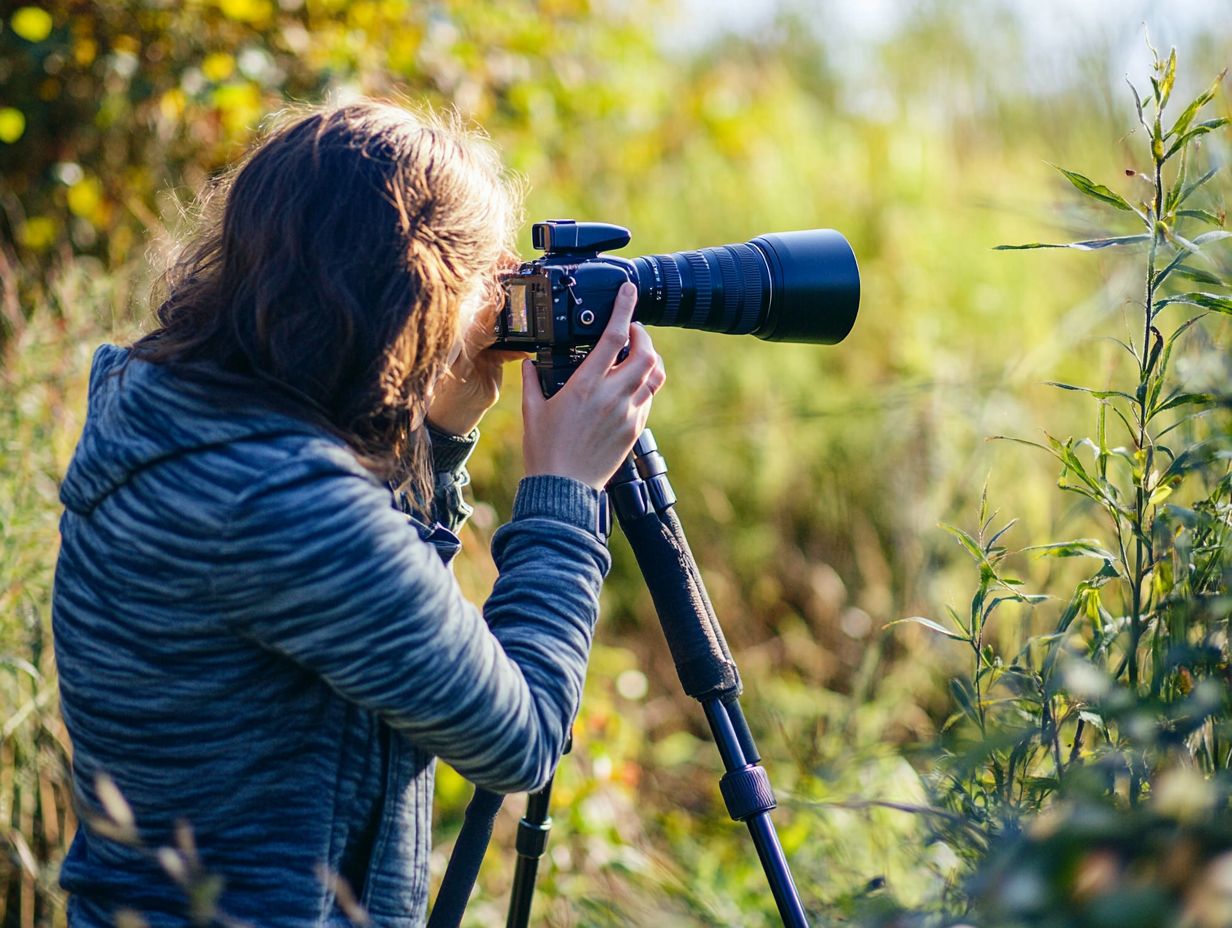
- Invest in a spotting scope with features designed for photography, such as eyepieces that can be changed based on your needs and camera adapters.
- Setting up and adjusting your spotting scope and camera properly can significantly enhance the quality of your photos.
- To avoid mistakes, pay attention to composition, lighting, and focus when using a spotting scope with a camera.
What is a Spotting Scope and How Does it Work?
A spotting scope is your go-to high-powered telescope, meticulously crafted for detailed observations over long distances, especially in outdoor settings like wildlife photography and birdwatching.
With advanced optical performance, these scopes allow you to achieve impressive magnification levels, bringing even the tiniest details into sharp focus and delivering stunning image quality.
You can easily pair them with various lenses, including telephoto options, enhancing their versatility for both amateur and professional photographers.
These optical wonders comprise essential components objective lenses, eyepieces, and prisms all working together to produce crisp, vibrant images. Unlike traditional binoculars, spotting scopes offer higher magnification ranges and a broader field of view, making them particularly beneficial for wildlife enthusiasts who want to capture intricate details from a distance without disturbing their subjects.
You also have the option to attach different filters to improve contrast and color saturation, elevating your photographic experience.
With their durable construction and weather-resistant features, spotting scopes are designed to withstand the rigors of outdoor adventures, making them essential for any serious wildlife photographer.
Benefits of Using a Camera with a Spotting Scope
Using a camera with a spotting scope presents you with numerous advantages, especially if you’re passionate about outdoor photography and wildlife shooting, where capturing those distant moments is key.
By leveraging the benefits of a spotting scope, you can enjoy exceptional image stabilization and resolution, ensuring your wildlife shots are sharp and clear, even from afar.
Whether you prefer a DSLR for its superior image quality or the convenience of a smartphone, integrating a camera with a spotting scope elevates your photographic journey.
This combination allows for a quick setup on a sturdy tripod, maximizing stability and providing flexibility in various shooting conditions be it low-light scenarios or bright, sunny days.
The ability to swiftly attach and detach your camera means you can effortlessly transition between capturing breathtaking landscapes and zooming in on wildlife.
This setup is designed for both amateur and seasoned photographers, simplifying the learning curve and allowing you to focus on composition while achieving stunning results.
Ultimately, merging these two powerful tools enhances your creativity and leads to breathtaking imagery.
Choosing the Right Spotting Scope for Photography
Choosing the right spotting scope for photography is essential for capturing stunning wildlife images with remarkable detail and high resolution.
Considerations such as optical quality, focal lengths, and how well the scope aligns with telephoto photography techniques are vital in determining its performance.
By investing in high-quality optics and incorporating accessories like a lens hood and camera adapter, you can significantly elevate your photography experience.
For more photography tips and to explore the best spotting scopes, subscribe to our newsletter or check out our recommended products!
Features to Consider
When you’re choosing a spotting scope for photography, there are several critical features you need to consider to ensure the best image quality and an enjoyable user experience. Start with the magnification levels; they dictate how close you can get to distant subjects. This is a key factor in your decision.
Don t overlook waterproof capabilities either after all, you want your scope to function beautifully in various outdoor conditions.
A stable camera mount and tripod stability are essential for achieving those sharp images you re after. The size of the opening in the lens that controls how much light enters also plays a significant role in light-gathering ability. Eye relief is another important aspect, especially if you wear glasses; it enhances comfort during those long shooting sessions.
Pay attention to the quality of the glass elements too, as they can significantly reduce distortion and provide clearer images. Lens coatings are worth considering as well, as they enhance light transmission and minimize glare. This is crucial for achieving photographic clarity in challenging lighting scenarios.
All these combined features not only elevate the quality of the images you capture but also contribute to a more enjoyable and efficient shooting experience outdoors.
Setting Up Your Spotting Scope and Camera
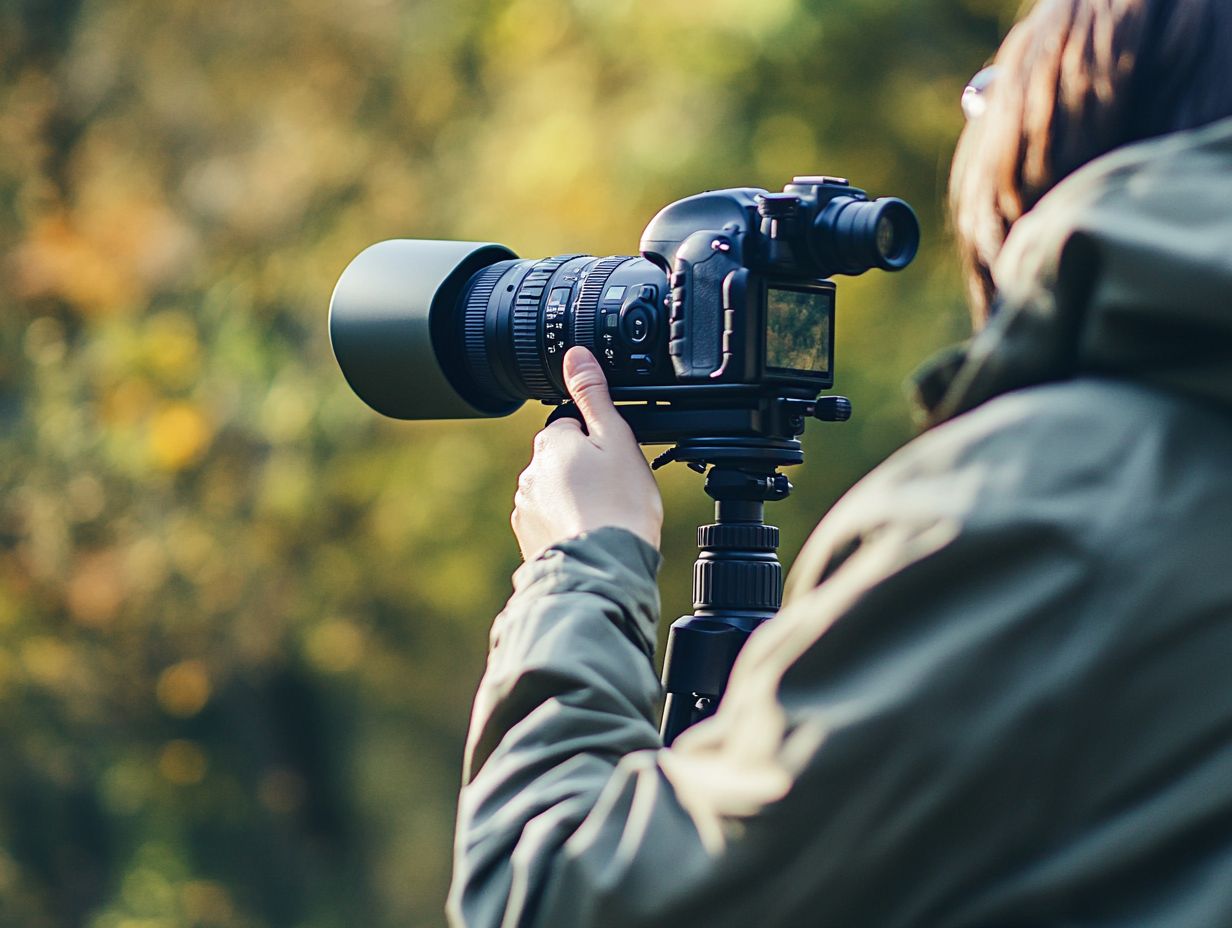
Setting up your spotting scope and camera with precision is essential for a seamless outdoor photography experience. It gives you the power to capture breathtaking wildlife images. A streamlined setup process improves your experience and allows you to concentrate on your subjects without the distraction of cumbersome configurations.
By ensuring proper lens attachment and employing a reliable camera adapter, you guarantee compatibility and functionality. This simplifies the transition between various lens types, including telephoto lenses.
Attaching the Camera to the Scope
Attaching your camera to the spotting scope is a vital step in ensuring your photos turn out vibrant and clear. Proper alignment and a secure camera mount are essential for maintaining stability during your shots especially in telephoto photography, where even the slightest movement can lead to significant blurriness.
A firm lens attachment optimizes image quality and allows you to capture the intricate details of wildlife in their natural habitats.
To achieve this effectively, start by choosing a compatible mount designed specifically for your scope and camera type. This choice will enhance stability and prevent any unwanted shake. Next, it’s crucial to carefully align your camera’s lens with the eyepiece of the spotting scope. For detailed instructions, refer to the step-by-step guide for setting up your spotting scope. You can usually accomplish this by adjusting the mount’s position until both visual fields coincide perfectly.
Finally, double-checking the tightness of the lens attachment ensures your camera remains secure throughout the shoot. This provides you with a seamless capture experience that showcases the wonders of nature without distraction.
Adjusting Settings for Optimal Photography
Adjusting your camera settings for optimal photography with a spotting scope is essential for capturing stunning wildlife images. Key settings include image stabilization to reduce blur, aperture control to manage light intake, and appropriate focal lengths to frame your subjects perfectly.
Whether you re wielding a DSLR or just your smartphone, understanding these settings will dramatically improve your wildlife photography experience.
Investing time to learn how to fine-tune these adjustments can truly enhance the quality of your shots. For instance, image stabilization is often built into DSLRs or can be paired with lenses that offer stabilization, while smartphone users can take advantage of digital stabilization options.
Aperture plays a crucial role as well; a wider aperture allows more light, enhancing those low-light scenarios, especially during the magical moments of early morning or late evening. Selecting the right focal length is key to isolating animals without disturbing them, resulting in more intimate photographs.
By experimenting with these configurations, you can achieve truly breathtaking images that convey the beauty and intricacy of nature.
Tips for Using a Spotting Scope with a Camera
To maximize your success with a spotting scope and camera, several key tips can significantly elevate your outdoor photography experience.
Pay attention to composition, master proper lighting, and employ effective focus techniques to capture breathtaking wildlife images.
Utilizing photography strategies specifically designed for spotting scopes will equip you to seize those fleeting moments with confidence and clarity.
Composition and Framing
Composition and framing are vital components in photography that significantly impact the visual allure of wildlife images captured with a spotting scope. Embrace principles like the rule of thirds and leading lines to enhance the aesthetic quality and storytelling potential of your photographs.
Implementing these tips ensures your outdoor captures convey a rich sense of place and narrative.
Position your main subject off-center and create dynamic lines that guide the viewer s eye to evoke lingering emotions. Consider your background; a clean, unobtrusive backdrop enhances visual clarity and prevents distractions from your focal point.
Experiment with various angles and perspectives for a unique portrayal of wildlife, showcasing their behavior and interactions with their environment. By mastering these techniques, you ll elevate the quality of your images and deepen the viewer’s connection to the natural world.
Lighting and Focus
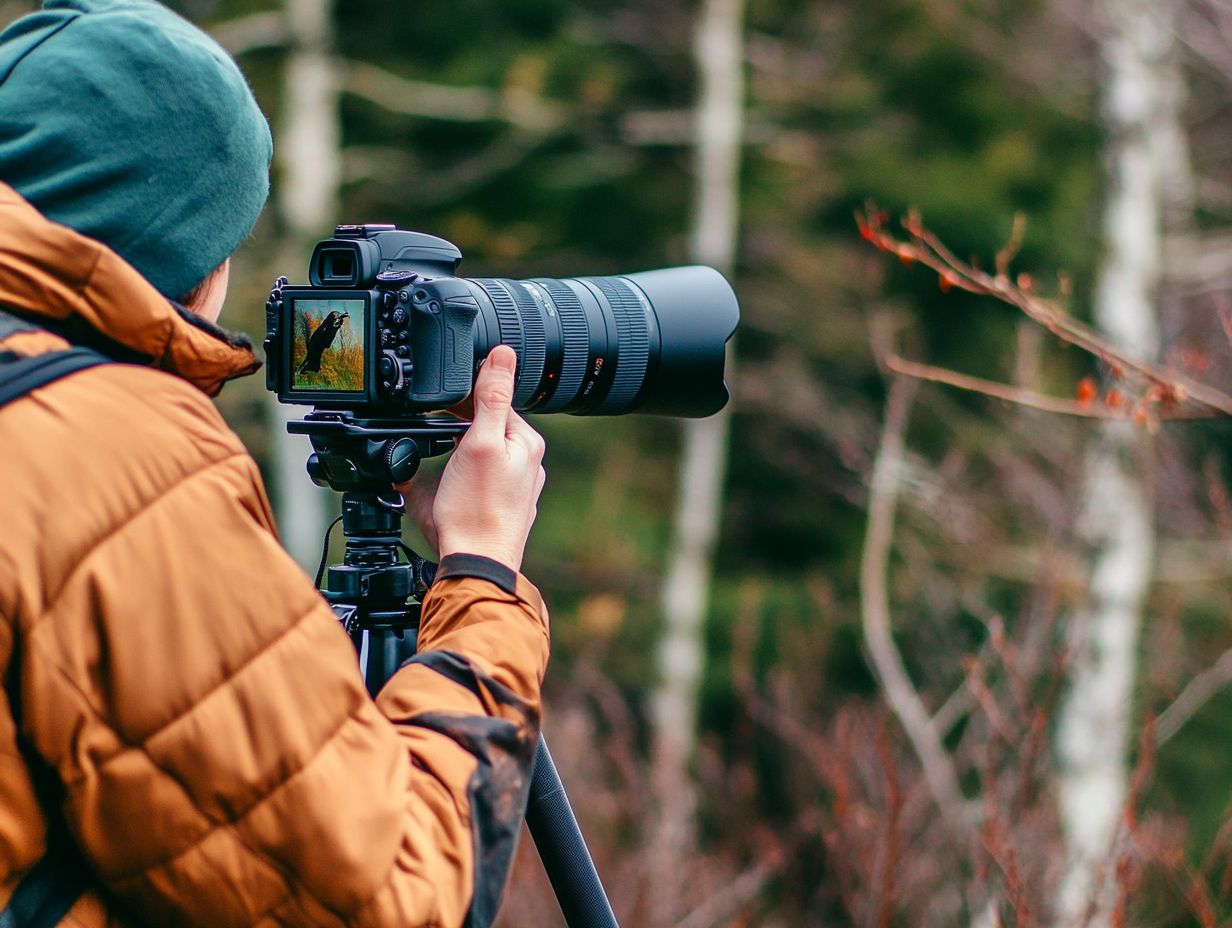
Mastering lighting and focus is essential for achieving exceptional image quality when photographing wildlife with a spotting scope. Proper lighting captures intricate details and vibrant colors, while achieving the correct focus ensures your subjects are sharp and well-defined.
Consider effective aperture settings, which refer to the size of the opening in the lens that lets in light and enhances the quality of your outdoor photography.
Shooting during the golden hour shortly after sunrise or before sunset bathes your images in a warm glow that naturally elevates their appeal. Using a wide aperture creates a soft background blur, making your main subject pop strikingly against its environment.
Balancing your ISO settings is equally critical; a lower ISO typically results in less noise, yielding cleaner images, especially in the variable lighting conditions found in the wild. Paying careful attention to these factors can significantly elevate your wildlife photography game.
Common Mistakes to Avoid
Avoiding common mistakes can greatly enhance your experience and results when using a spotting scope with a camera for wildlife photography. Blurred images often stem from insufficient image stabilization or improper handling, detracting from your enjoyment.
Recognizing and addressing these prevalent pitfalls will help you refine your techniques and capture stunning high-quality wildlife images.
Blurred Images and Other Issues
Blurred images are a frequent challenge when using spotting scopes, often due to inadequate image stabilization or focus errors. Combat this issue by using a sturdy tripod and ensuring precise focus to enhance your wildlife photography.
Secure your equipment and ensure the scope is level and free from vibrations to greatly improve clarity. Wildlife can be unpredictable, so opt for fast shutter speeds and a higher ISO setting to capture sharp images during fleeting moments.
Optimize the focus points on your camera manual focus can be a lifesaver in complex environments where automatic settings might falter. Pay close attention to lighting conditions and position yourself to avoid harsh shadows, elevating the vibrancy of your shots and resulting in stunning portrayals of nature.
Caring for Your Equipment
Caring for and maintaining your spotting scope and camera equipment is crucial for ensuring optimal performance and longevity. By following regular cleaning and maintenance tips, you can preserve the functionality of your photography gear and prevent dirt and debris from compromising image clarity.
Investing in a waterproof scope enhances its durability. This allows it to thrive in various outdoor conditions.
Cleaning and Maintenance Tips
Regular cleaning and maintenance of your spotting scope and camera equipment are essential for preserving image clarity and ensuring peak performance.
Adopt best practices that keep your gear looking immaculate and elevate your shooting experience. For instance, use a soft microfiber cloth to gently wipe your lenses. This removes dust and fingerprints without causing scratches. A lens cleaning solution specifically formulated for optical devices can effectively tackle stubborn smudges.
Regularly check for debris on the body of your camera or scope. This helps prevent problems that might stop your equipment from working.
Many enthusiasts recommend storing your equipment in a dry, protective case. This shields it from moisture and potential damage. Experience the thrill of capturing stunning, crystal-clear images!
Frequently Asked Questions
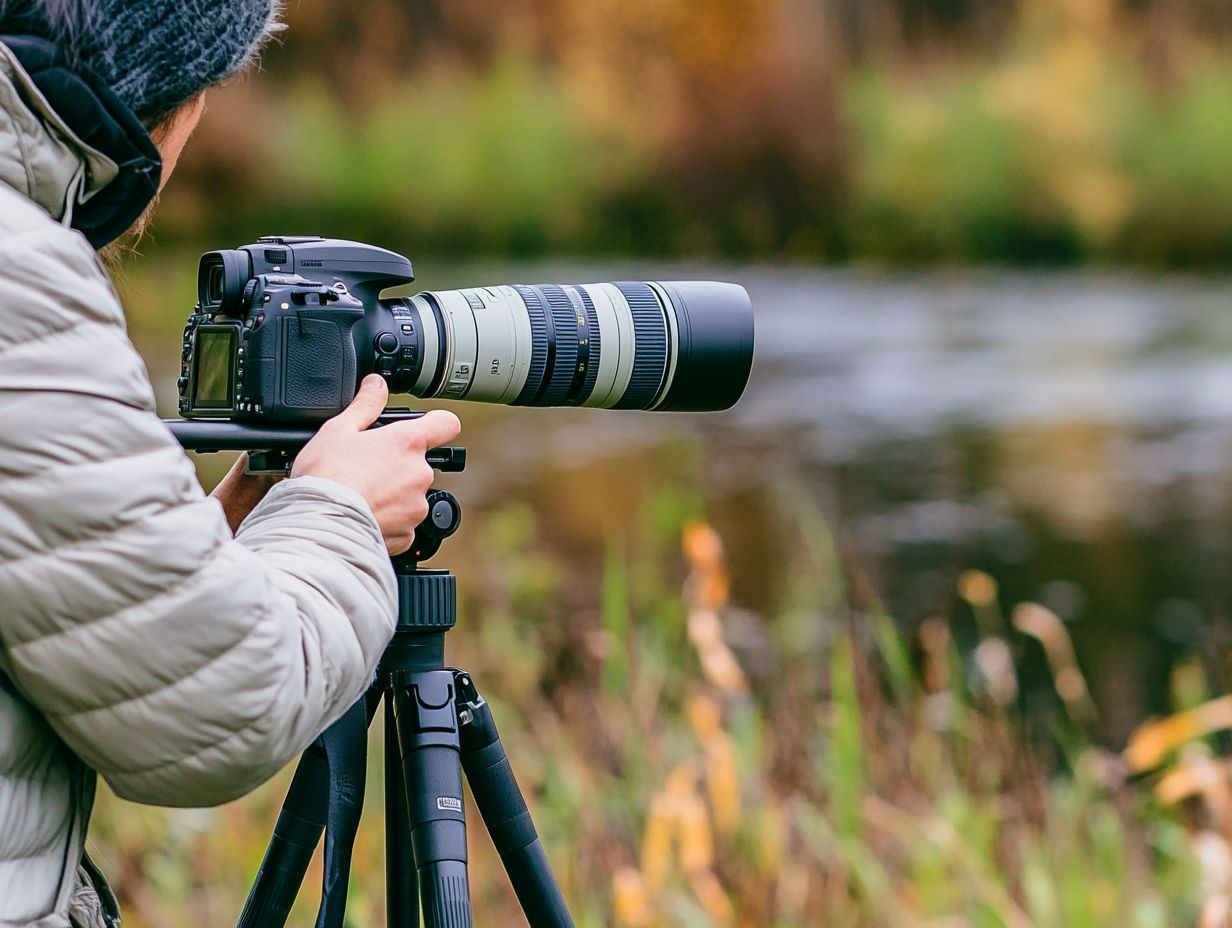
What is a spotting scope?
A spotting scope is a type of optical instrument used for viewing objects at long distances. It is similar to a telescope but offers a wider field of view and lower magnification.
Can I use a spotting scope with a camera?
Yes, you can use a spotting scope with a camera by attaching the camera to the eyepiece of the scope. This allows you to take photos or videos of distant objects using the scope’s magnification.
What type of camera can I use with a spotting scope?
You can use any camera with a spotting scope as long as it has a removable lens and a tripod mount. This includes DSLR, mirrorless, and point-and-shoot cameras.
How do I attach my camera to a spotting scope?
To attach your camera to a spotting scope, you will need a specific adapter designed for the eyepiece of the scope and your camera. These adapters are available at most camera and optics stores.
What are the benefits of using a spotting scope with a camera?
Using a spotting scope with a camera allows you to capture high-quality photos and videos of distant objects, including wildlife, landscapes, and celestial objects. For those new to this hobby, spotting scope use tips for beginners can help you get closer to your subject without disturbing it.
Are there any tips for using a spotting scope with a camera?
Yes, here are a few tips: Use a stable tripod to avoid camera shake. Consider using a remote shutter release or self-timer to minimize camera movement. Adjust the focus and zoom on the scope for the best image quality.

